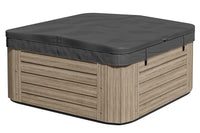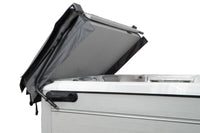If you own a hot tub, you already know how much comfort and relaxation it brings. Few things compare to slipping into warm bubbling water after a long day. But there is a hidden threat most spa owners overlook. Moisture buildup and wet leaves can quietly destroy your hot tub cover. These elements might appear harmless at first, yet over time they weaken materials, encourage mold, and reduce insulation.
At The Cover Guy we build covers engineered to resist moisture damage, mold, and mildew so your investment lasts longer. Here is what you need to know about this hidden enemy and how to fight it.
Causes of Hot Tub Cover Damage
Damage does not happen overnight. It starts small, with everyday exposure to weather, chemicals, and debris.
Condensation and trapped moisture
After every soak, warm vapor rises from your spa. When it meets the cooler underside of your cover, it condenses. According to the US Environmental Protection Agency (EPA)’s Mold Course Chapter 4, moisture that is not dried within 24 to 48 hours encourages mold to grow and spread. That means your cover’s foam core and seams are at risk the moment moisture becomes trapped. Over time this trapped water makes the cover heavier and less effective at retaining heat.
Wet leaves and yard debris
Leaves may look harmless when they fall, but once they absorb water they cling to the cover and keep surfaces damp. The EPA explains in its Mold Remediation Guide that moisture is the single most important factor in mold growth and must be controlled to avoid long term damage. A single wet leaf can create a damp spot that breeds mildew and stains the vinyl shell.
The most effective defense is choosing a reliable hot tub cover so debris never has the chance to settle and cause damage in the first place.
Leaves also contain natural compounds such as tannins and organic acids. When those compounds leach into standing water on your cover, they can cause discoloration that is very difficult to clean. Over time the acidic nature of decomposing leaves weakens the shell surface and encourages microbial growth. What looks like a few soggy leaves left after a storm can begin a slow chemical process that eats away at your cover.
Chemical vapors from the spa itself
Even well-maintained water chemistry creates vapor. But when levels drift off balance, the vapors become corrosive. They rise under the cover, attacking vinyl, vapor barriers, and stitching. The result is cracking, discoloration, and eventually waterlogged insulation that no longer traps heat.
One of the simplest ways to reduce this risk is learning how to clean hot tub covers properly and regularly, since cleaning removes chemical residue before it can cause long term damage.
Standing water and snow load
If your cover is flat or sagging, rainwater and snow sit on top. That added weight compresses the foam core, stretches seams, and accelerates breakdown. The CDC Healthy Swimming guide highlights the importance of using covers to keep environmental debris and precipitation out of hot tubs to reduce contamination.
Hot Tub Cover Construction and Materials
Knowing what makes up a cover helps you understand where moisture attacks.
Outer shell
The vinyl or coated fabric shell is the first line of defense. If it cracks from sun exposure or age, water can seep in. The EPA notes in its Brief Guide to Mold, Moisture, and Your Home that surfaces exposed to persistent dampness are at higher risk of mold damage. That means even tiny cracks can become entry points for bigger problems.
Regular inspections and proper care are essential if you want to prevent mold on hot tub cover surfaces and keep the shell in good condition year after year.
Foam core and vapor barrier
Inside your cover is a foam core wrapped with a vapor barrier. The foam provides insulation, while the barrier keeps it dry. Once the barrier fails, the foam absorbs water, loses insulation value, and becomes heavy. A waterlogged foam core can double or triple the weight of your cover, making it unsafe to lift and less energy efficient.
Seams and stitching
Seams are especially vulnerable. Weak stitching or damaged seams let water in. Over time these become entry points for mold and mildew that spread deeper into the cover. The damage usually begins inside and only becomes visible once the structure is already compromised.
Warning Signs of Hot Tub Cover Damage
A failing cover shows itself if you know what to look for. These signs of hot tub cover damage often mean moisture or leaves are taking their toll:
- The cover feels much heavier than it used to, a common sign of waterlogged foam
- A persistent musty odor appears when lifting the cover, signaling mold or mildew inside
- Cracks or tears form in the vinyl, especially near seams or corners
- The surface begins to sag and collect water instead of shedding it
- Your spa takes longer to heat, and energy bills rise, showing insulation loss
- Stains or discoloration show up where wet leaves sat for too long
When these signs appear, it is time to take corrective action before the damage spreads.
The Cost of a Failing Cover
The damage from moisture is not only cosmetic. It also has a financial impact. A waterlogged or poorly insulated cover allows heat to escape more quickly. That means your heater has to run longer and more often. Even small losses in insulation add up to noticeable increases in your energy bills each month. Over a year, that could mean hundreds of dollars wasted simply because the cover is no longer keeping heat in.
In addition, the EPA warns that mold growth can spread beyond the cover itself and affect surrounding surfaces if moisture is not controlled. For spa owners this could mean cleaning or even replacing nearby decking or spa surrounds. Investing in a cover that resists moisture is therefore not just about convenience, it is about long-term cost savings and protecting your entire backyard setup.
Maintenance and Prevention Tips
With the right habits you can simplify hot tub cover maintenance with hot tub lifters and extend its useful life.
Clear leaves quickly
Remove wet leaves as soon as possible. Do not let them sit long enough to stain or trap water.
Dry and ventilate
Lift the cover after each use to let air circulate. The EPA emphasizes drying damp items quickly as the key to preventing mold. Even ten minutes of ventilation can make a difference.
Clean correctly
Use mild soap and water for cleaning. Avoid bleach or harsh detergents. For details on safe cleaning, see EPA’s guidance on mold and moisture control.
Protect against sun
Apply vinyl protectants that shield against UV rays and prevent cracking. Sun damage accelerates water penetration.
Balance spa chemistry
Keep chlorine or bromine at correct levels. If you shock the water, leave the cover off to allow vapors to escape.
Remove snow and pooling water
Brush off snow with a soft broom. Use a squeegee to remove rainwater so weight does not build up.
Protective Accessories for Hot Tub Covers
Accessories provide low-cost insurance against the elements.
- Cover lifters make it easier to open and close, encouraging frequent ventilation
- Cover caps or tarps add defense during long vacations or harsh winters
- Leaf guards or trimming nearby trees reduce debris landing on the cover
- Floating thermal blankets minimize evaporation and reduce condensation buildup under the cover
Upgrades and Features for Moisture Protection
When shopping for a new cover or upgrading an existing one, choose features that address moisture directly.
- High density foam cores with sealed vapor barriers that resist waterlogging
- UV stabilized outer shells that withstand sunlight without cracking
- Reinforced seams that block water intrusion and resist tearing
- Tapered tops designed to shed rain and snow rather than collect it
- Locking straps for a tight fit that keeps wind, leaves, and moisture out
Knowing When It Is Time to Replace Your Spa Cover
Even the best maintained cover will not last forever. Replacement becomes necessary when:
- Foam cores are permanently waterlogged and heavy
- Vinyl shells are cracked, or seams have failed beyond repair
- Insulation has degraded and heating costs rise noticeably
- The cover emits a strong musty odor despite cleaning
- The cover is more than seven or eight years old in harsh climates
At that stage, investing in a new durable hot tub cover is the smart choice to ensure your hot tub continues to perform efficiently and safely.
Why The Cover Guy Covers Last Longer
The Cover Guy provides durable hot tub covers that are built to resist the very threats we have discussed.
- Engineered to fight moisture damage, mold, and mildew for long lasting protection
- Made with weather resistant materials that prevent wet leaves from breaking down your cover
- Custom fit designs that seal tightly to preserve insulation and block water
- Low maintenance solutions that cut down on cleaning and delay replacement
- Trusted across North America for year-round defense against rain, snow, sun, and debris
- Practical Action Plan for Hot Tub Owners
You can take simple steps today.
- Inspect your cover for stains, odors, or excess weight
- Clear off wet leaves after every storm or windy day
- Ventilate after use to let moisture escape
- Clean regularly with mild soap and rinse thoroughly
- Apply protectant to keep the shell flexible and water resistant
- Replace when the cover shows multiple signs of failure
Sustaining Your Investment
Moisture and wet leaves are not just seasonal annoyances. They are long term enemies of your hot tub cover. Left unchecked, they reduce insulation, trap mold, and force early replacement. With prevention, smart accessories, and a high quality replacement when needed, you can extend your hot tub cover lifespan by years. At The Cover Guy, we specialize in custom, durable hot tub covers designed to resist moisture, fight mildew, and withstand the elements. Protect your spa investment today and enjoy peace of mind for seasons to come.








